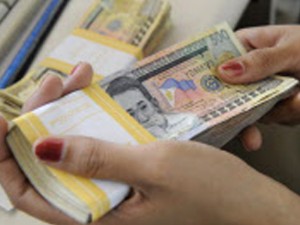
AT ITS LOWEST The peso hit the 44:$1 territory on Tuesday, Oct. 4, 2011, settling at 44.08, its lowest level in eight months, due to the prolonged eurozone debt crisis.
The peso weakened to the 44-to-a-dollar territory on Tuesday and hit its lowest finish in eight months as the prolonged debt crisis in the eurozone prompted portfolio investors to pull out funds even from better-performing Asian economies.
The local currency closed at 44.08 against the greenback on the second trading day of the week, down 9 centavos from the previous day’s finish of 43.99:$1.
Tuesday’s close was the weakest in about eight months. The last time the peso hit a level weaker than Tuesday’s was last February 1 when the local currency closed at 44.21 to a dollar.
Intraday high on Tuesday was 43.94:$1 while intraday low was 44.23:$1. Volume of trade amounted to $1.2 billion.
Traders said the depreciation of the peso reflected the movement of other emerging market currencies. They said that at this time when the global economic outlook was uncertain, portfolio fund owners preferred holding on to dollars to stay safe. Consequently, they withdraw securities investments, including those from emerging markets like the Philippines.
The peso could have been weaker were it not for the intervention by the Bangko Sentral ng Pilipinas (BSP), according to market players.
BSP Governor Amando Tetangco Jr. said the central bank has a policy of allowing a market-determined exchange rate, but would intervene in the foreign exchange market from time to time to avoid sharp fluctuations.
For the BSP, a volatile exchange rate was disruptive to businesses and to the general economy.
Tetangco told reporters that despite the depreciation of the peso on Tuesday, the currency remained competitive as the volatility of the local currency was just about the average volatility of Asian currencies.
“The peso’s movement is indicative of risk aversion in the face of greater global financial volatility,” Tetangco said.
The Philippines, like other emerging markets, is exposed to the crisis in the eurozone through various channels, mainly exports and remittances.
Europe is one of the biggest export markets for countries like the Philippines. It is also home to many overseas Filipino workers whose remittances help fuel consumption of domestic households.
Remittances from Europe accounted for about 17 percent of total funds being sent to the Philippines.
The BSP, nonetheless, has expressed confidence that remittances would still exceed the $20-billion mark as targeted this year despite the prolonged debt crisis in the eurozone.
The BSP expects remittances to grow at a faster pace in the fourth quarter, thus pull up the average growth for the full year. In the fourth quarter, remittances usually rise at a faster clip as overseas Filipinos send more money for the Christmas season.
“Remittances have proven to be resilient in the past,” Tetangco said. “A 7-percent growth in remittances to over $20 billion is attainable.”
Data from the central bank showed that in the first seven months of the year, remittances amounted to $11.4 billion, up 6.3 percent year on year.
Last year, remittances amounted to $18.8 billion.
Tetangco said there were alternative labor markets such as in Asia where demand for foreign workers remained high. He said this was one reason why remittances continued to grow despite a tough global economic climate.
Remittances are a closely watched economic indicator for the Philippines since these largely fuel household consumption, which in turn serves as a significant driver of economic growth.

